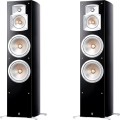Sensitivity
Speaker sensitivity.
This characteristic is indicated on the basis of how loud the acoustics are capable of producing when a signal of a certain standard power is applied to it. Simply put, the higher the sensitivity of the speaker, the louder it will sound at the same output power of the amplifier. Thus, sensitive acoustics can be effectively used even in combination with relatively low-power "amplifiers". On the other hand, low sensitivity also has its advantages: it allows you to achieve a more uniform frequency response and reduces the likelihood of overloading the amplifier. In the least sensitive modern speakers, this indicator
does not exceed 84 dB, in the most sensitive it is
95 – 96 dB or
more.
Note that in fact, you have to pay attention to this parameter when acoustics are planned to be used with a separately selected power amplifier. Therefore, for active systems (see "Type"), sensitivity is purely a reference value, and, usually, it can be ignored when choosing.
Overall frequency range
The total frequency range that the speaker is capable of reproducing. Specified from the bottom of the range in the lowest frequency component to the top of the range in the highest frequency: for example, in a 2.1 system with main speakers at 100 – 22000 Hz and a subwoofer at 20 – 150 Hz, the total value will be 20 – 22000 Hz.
The wider the frequency range — the fuller the reproduced sound, the lower the likelihood that some part of the low or high frequencies will be "cut off". It is worth noting here that the human ear perceives frequencies on average from 16 Hz to 22 kHz, and from a practical point of view, it makes no sense to provide a wider frequency range in speakers. However, quite a few models go beyond this range, sometimes quite significantly (for example, there are speakers with a range of about 10 – 50,000 Hz). Such characteristics are a kind of "side effect" of high-end acoustics, and they are usually given for advertising purposes.
Thus, the lower limit of the range in modern speakers can be within frequencies
up to 20 Hz, however, higher values \u200b\u200bare more common —
30 – 40 Hz,
40 – 50 Hz, or even
more than 70 Hz. In turn, the upper limit in most modern speakers lies in the range
19 – 22 kHz, although there are deviations both upwards (see above) and
downwards.
Tweeter size
The diameter of the tweeter (speakers) speakers. Since size primarily affects the range of the speaker (as the diameter increases, the operating frequencies decrease), in HF components it can be quite small. More detailed information can be found in special sources.
Midrange speaker size
The diameter of the midrange speaker(s) speakers. The size of the speaker determines its operating range, as well as the total power: the larger the diameter, the lower the frequencies and the larger the radiating surface area (and hence the power). Accordingly, the dynamics for the midrange can be quite large, but in this case this parameter cannot be called critical. More detailed information can be found in special sources.
Woofer size (LF/MF)
The diameter of the woofer or combined woofer/midrange speaker(s). The larger the speaker, the lower its operating frequencies and the more sound power it can provide. Therefore, you should pay special attention to this parameter if you want to get high-quality rich bass - especially if we are talking about an audio system without a subwoofer. More detailed information about speaker sizes can be found in special sources.
Finishing material
The material from which the cabinets of the speakers included in the speakers are made. Not only the appearance, but also the sound characteristics depend on this parameter. The most common options are:
—
MDF(Medium Density Fiberboard — medium density fibreboard). The most popular material today, found in almost all price categories. At a rather low price, MDF has good acoustic characteristics, almost as good as natural wood.
—
Tree. Wood can be classified as a premium material: it looks nicer than MDF, but in terms of acoustic properties it does not have significant advantages, but is noticeably more expensive. Because of this, this material is found mainly among high-end speakers designed for demanding users.
—
Plastic. Plastic is low cost and easy to process. Its acoustic properties are worse than those of MDF and, moreover, wood; however, this shortcoming can be easily compensated for. So such cases are very popular nowadays, they are found even in high-end speakers.
—
Metal. Most often, metal speaker cabinets are made of aluminium alloys. This provides an elegant appearance, in addition, such cases are very durable, reliable and are not afraid of scratches, dirt and moisture. On the other hand, metal is not cheap, and in some models it gives the sound a specific coloration that may not be to every
...one's liking. To eliminate this effect, various design tricks can be applied, which, again, additionally affect the cost.
Note that for systems with a subwoofer (2.1, 5.1, etc., see “Number of channels”), this parameter specifies the material of the main speakers, while the subwoofer is in most cases made of MDF.Weight
The total weight of all components of the speaker system.

